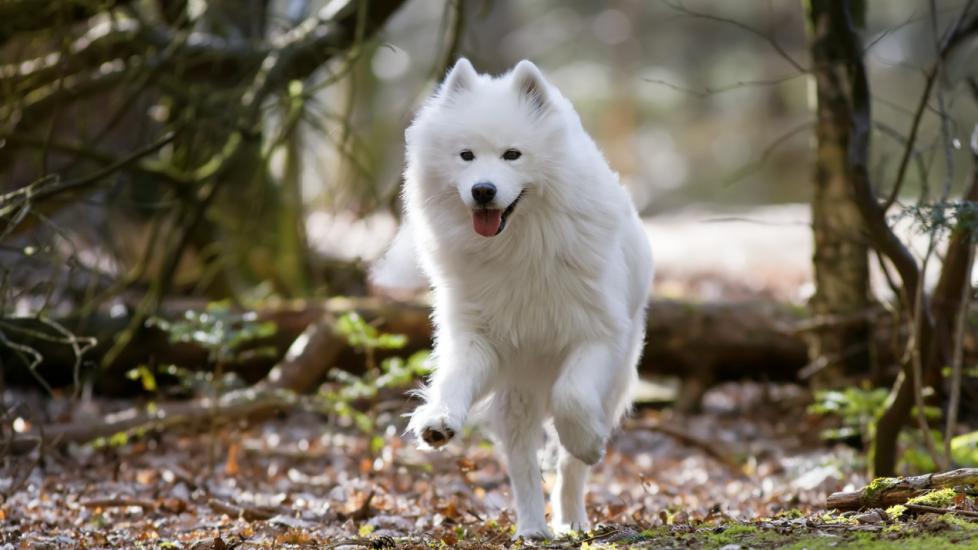Samoyed
iStock/BoValentino
The Samoyed dog (pronounced suh-moy-uhd) is best known for their pure-white fluffy coat, curled tail, friendly personality, and love of cold weather.
These dogs are built for working in extremely cold climates—they were originally bred to herd reindeer and pull sleds for the Samoyed people in northwestern Siberia, according to the Samoyed Club of America (SCA). Because of their northern origins, Samoyeds have a very thick two-layer coat that consists of a long straight-haired topcoat and a dense soft undercoat.
They are medium- to large-sized dogs; Samoyeds weigh 35–65 pounds and confidently stand 19–23.5 inches tall.
Caring for a Samoyed

As a playful, alert, and friendly dog, a Samoyed’s temperament can make a great companion for first-time pet parents who are ready to meet the high exercise and grooming needs this working demands.
Samoyed dogs require daily brushing and do not do well in hot temperatures. Pet parents should be aware that a Samoyed can develop heatstroke in hot weather and monitor their dog for signs of overheating. That said, Samoyeds thrive in colder climates and love running through the snow.
The Samoyed is an athletic working dog and does not tire easily. These dogs are most known for pulling sleds, herding, agility, and hunting. They need regular exercise (at least two hours a day!) and are very playful pups that love to be around people and other dogs.
Samoyed Health Issues

If you’re bringing home a Samoyed puppy, know that they can live for 12–14 years—about the typical lifespan for a medium-sized dog.
They can develop a few health conditions over the course of their life, and their sensitivity to warmer temperatures can lead to other medical issues. Purchasing dog insurance may be a good investment for your Samoyed.
Retinal Diseases
The retina is in the back of the eye; it senses light and sends information to the brain for visual recognition. Two retinal diseases often found in Samoyeds are:
-
Retinal dysplasia: This is when abnormal folds in the retina lead to decreased vision and eventually blindness. In Samoyeds, retinal dysplasia can be a genetic disease and screened with a dog DNA test.
-
Progressive retinal atrophy (PRA): PRA is a genetic disorder that causes the retina’s light sensors (photoreceptors) to die, leading to blindness in the young to middle-aged Samoyed dogs. There is also genetic DNA testing available to screen for PRA.
Uveodermatologic Syndrome (UDS)
UDS in dogs is a skin and vision disease where a dog’s own immune system abnormally attacks melanin production.
Melanin is responsible for the various pigment shades of the skin and hair, and certain structures of the eyes. UDS can cause various skin lesions and lightening of the skin (depigmentation), along with inflammation in the eyes and vision problems.
Treating UDS typically involves steroids and/or cyclosporine to help suppress the immune system response.
Heart Problems
Samoyeds can be predisposed to several heart problems, including:
-
Atrial septal defect (ASD): As an embryo develops, a hole is naturally present between the heart’s left and right atria (the two upper chambers) before closing before birth. But in dogs with ASD, the hole is still present after birth and can case abnormal blood flow and heart failure.
-
Aortic stenosis: This refers to a narrowed opening of the aortic valve in the heart, which develops as the dog ages. While a heart murmur may be observed on a physical exam by a veterinarian, this condition often does not cause any major issues, and affected dogs can live a normal life. However, with severe aortic stenosis, clinical signs such as lethargy, shortness of breath, coughing, or collapse may occur.
-
Pulmonic stenosis: Like aortic stenosis, this is a congenital disease that involves a narrowing of the pulmonic valve in the heart. Pulmonic stenosis may or may not cause clinical signs of lethargy, shortness of breath, coughing, or collapse.
In general, any heart problem diagnosed by a veterinarian should be monitored regularly with an echocardiogram (heart ultrasound), chest X-rays, and blood tests.
Hip Dysplasia
Hip dysplasia is a condition in which the hip joint does develop properly and can cause pain and arthritis without treatment. While there is a genetic predisposition to this condition, lifestyle habits and certain factors—including a Samoyed’s growth rate, muscle mass, diet, and exercise—can contribute to the development of hip dysplasia.
Testing is available to detect the likelihood that dogs will develop hip dysplasia in their lifetime. If your dog is diagnosed with hip dysplasia, there are a few options for treatment and long-term management, including joint supplements, medications, weight management, and surgery.
Samoyed Hereditary Glomerulopathy (SHG)
SHG is a genetic kidney disorder often seen in Samoyeds. It affects the glomerulus, which is the kidney filter.
When the glomerulus is affected by SHG, proteins from the blood, such as albumin, will spill over into the urine. Over time, this leads to kidney failure.
There is a genetic DNA test available for SHG, and reputable Samoyed breeders will screen their dogs to avoid passing this condition to puppies. While there is no specific treatment or cure, certain medications and high-quality, protein-restricted “kidney-friendly” diets may help slow disease progression.
What To Feed a Samoyed
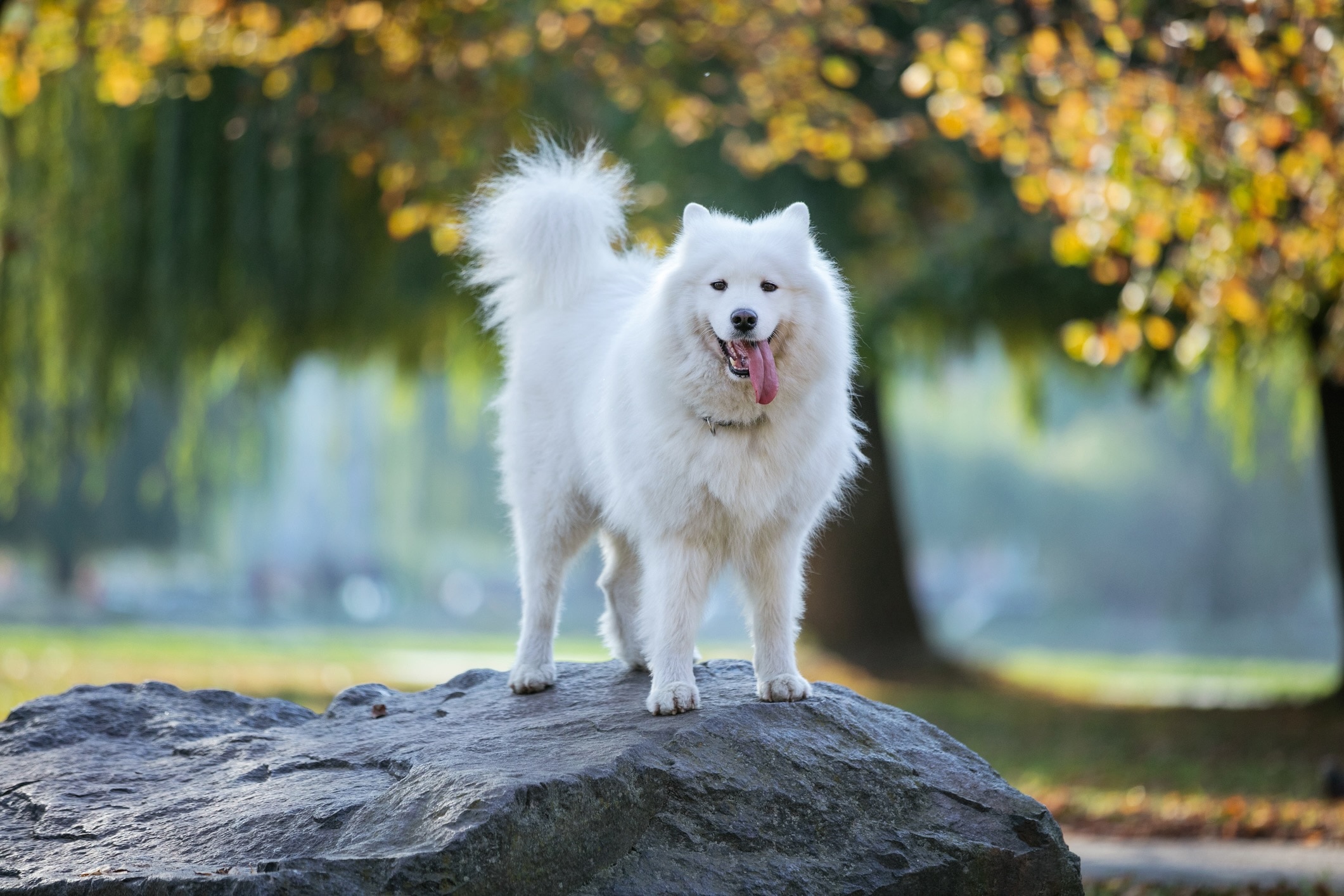
Samoyed puppies under 1 year old need a high-quality puppy food that meets nutritional standards set by the Association of American Feed Control Officials (AAFCO). Older Samoyeds (7 years and up) should be offered a high-quality senior food that is also AAFCO-compliant.
Samoyeds involved in routine herding, sledding, or other strenuous exercise need a high-quality dog food with a greater protein content than what would be offered for a typical house dog. For a less-active family companion, overfeeding or offering excessive amounts of treats during the day should be avoided to prevent obesity in your dog.
Always talk to your veterinarian, who can help you choose the best food for your dog’s specific needs. Again, a Samoyed with SHG should be fed a high-quality, protein-restricted, kidney-friendly diet to help slow disease progression.
How To Feed a Samoyed
As with most dog breeds, it’s appropriate to feed an adult Samoyed twice a day, in the morning and evening. Samoyed puppies may benefit from eating more frequent meals (three or four a day). Fresh water should always be available.
How Much Should You Feed a Samoyed?
In general, the amount of dog food offered should be based on the ideal weight of an adult Samoyed, which is typically 35–65 pounds. For most commercial dog foods, refer to a feeding guideline printed on the package.
Your veterinarian can also work with you to determine the appropriate amount of food per day for your individual Samoyed based on their health, lifestyle, and other factors.
Nutritional Tips for Samoyeds
For very active Samoyeds, adding glucosamine and omega-3 supplements (such as fish oil) can help promote joint health. There are also some commercial joint-health dog foods available that contain added omega-3 and/or glucosamine.
Always talk with your veterinarian before adding a supplement to your dog’s diet.
Behavior and Training Tips for Samoyeds
Samoyed Personality and Temperament
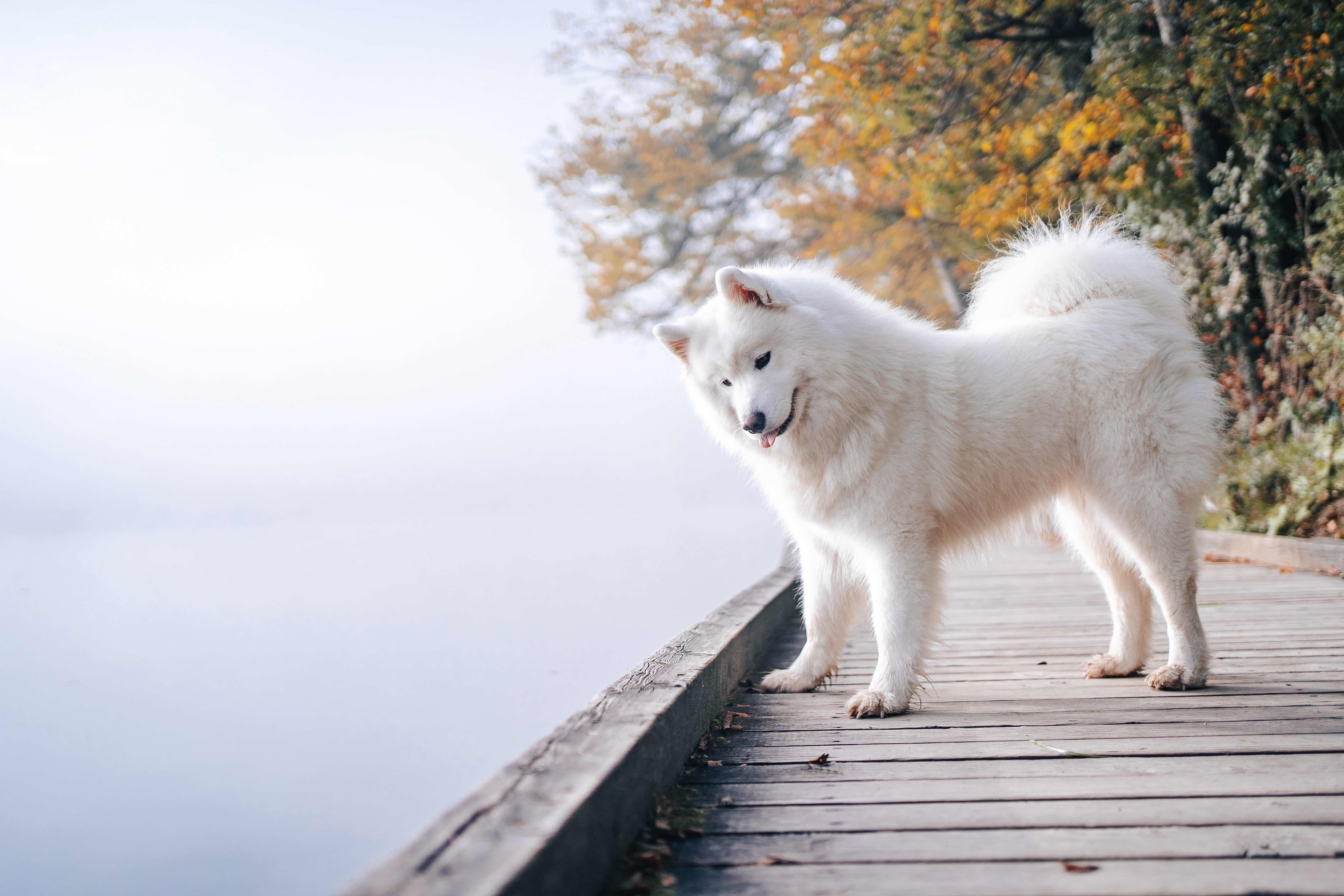
Every dog is an individual with their own personality, but the average Samoyed dog temperament is influenced by their background. Because of their history as working and herding dogs, Samoyeds are clever, quick-witted, and even mischievous, according to the breed club.
They are adaptable dogs that can get along well with other dogs, cats, and children with the right socialization and introductions.
Samoyed Behavior
Despite being hard workers, Samoyed dogs are extremely playful and need lots of exercise and mental stimulation to prevent boredom. A bored Samoyed is bound to develop destructive behaviors like chewing and digging.
Supervise your Samoyed when they’re around smaller animals like cats, rabbits, or neighborhood squirrels—they may try to herd these critters and even small children. It’s important to keep your dog on a leash or within a fenced area whenever they’re outside, too, to stop them from wandering off to explore.
Samoyed Training
As with all dog breeds, Samoyed puppies respond best to training and socialization early in life. Begin training your puppy as soon as you bring them home; Samoyeds are smart dogs that respond well to cues and learn quickly, according to the SCA.
Socializing your puppy should also begin when they come home. Ask your Samoyed breeder how they’ve approached socialization so far and get advice from your veterinarian on how to safely expose your pup to new situations. A puppy that’s well-socialized will grow into a well-mannered adult dog.
Fun Activities for Samoyeds
Samoyed Grooming Guide
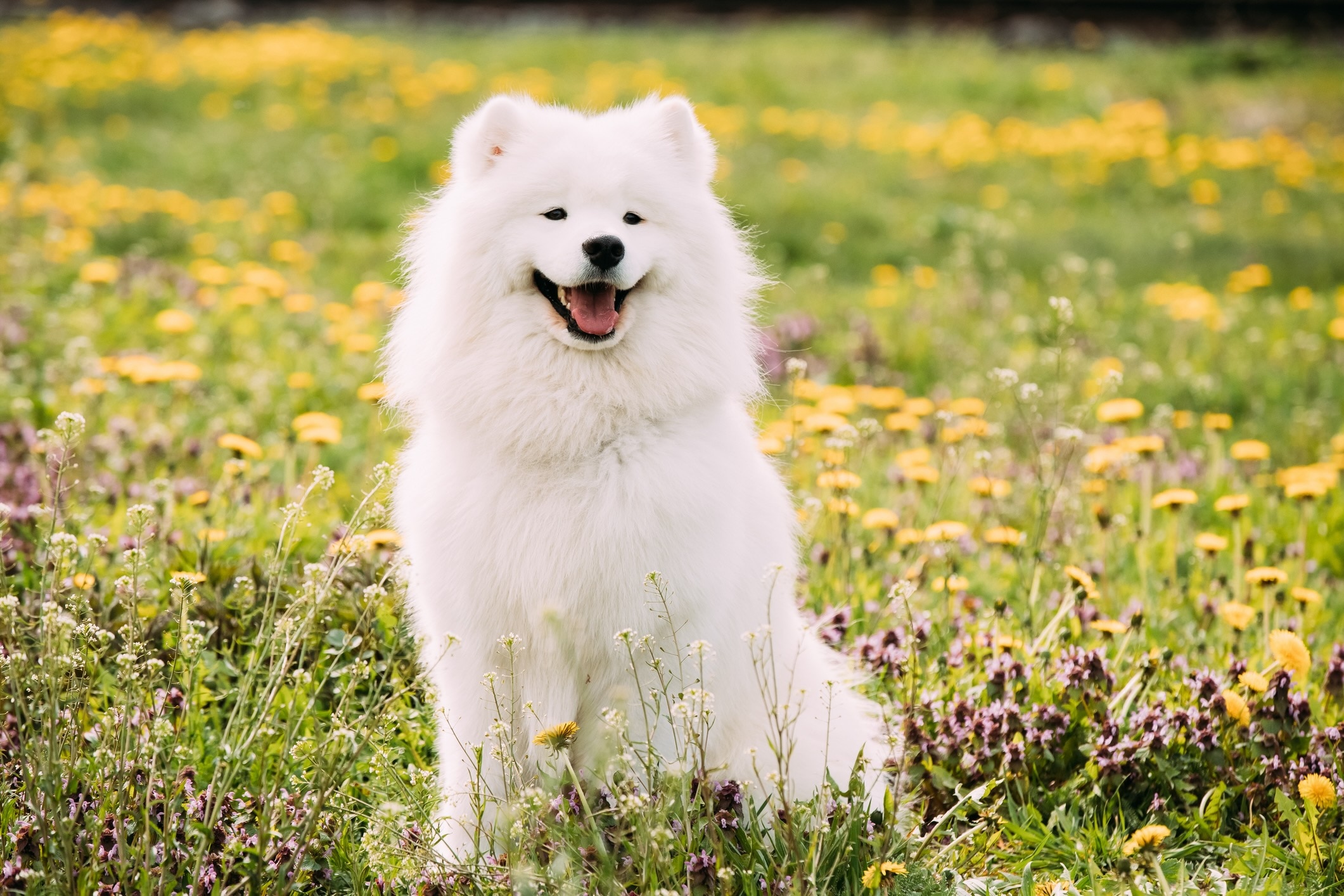
The Samoyed has a thick two-layer coat that consists of a long straight-haired topcoat and a dense soft undercoat. These dogs shed regularly year-round and require consistent brushing.
Skin Care
Samoyeds don’t require specialized skin care and aren’t especially prone to skin conditions. Talk to your vet if you notice any changes in your dog’s skin.
Coat Care
Regular bathing is not required for Samoyeds unless they become dirty. Care should be taken to dry the Samoyed’s hair coat with a large towel or hair dryer on a low setting after bathing. Any lingering moisture can cause skin infections in your dog.
Brushing your dog’s fur every day will help to maintain its integrity and beauty. A de-shedding brush, such as the FURminator®, can help remove excess undercoat, especially during warmer months, to help reduce shedding and keep your Samoyed cool.
Eye Care
Because Samoyeds may be prone to certain eye problems, it’s important to have their eyes examined at least once a year by a veterinarian. Along with regular checkups, schedule an appointment with your vet if you notice any changes in your dog’s eyes, including redness, discharge, or cloudiness.
Because of their white coat, a Samoyed may develop tear staining. Tear stains in dogs are typically normal and not caused by a health condition, but talk to your vet if you have any concerns. You can remove your dog’s tear stains with vet-approved cleaning products.
Ear Care
After every bath, splashing in water, or rolling around in the snow, Samoyeds should have their ears cleaned with a dog-specific ear cleaner. Diligent ear cleaning can help prevent ear infections in your dog.
Considerations for Pet Parents
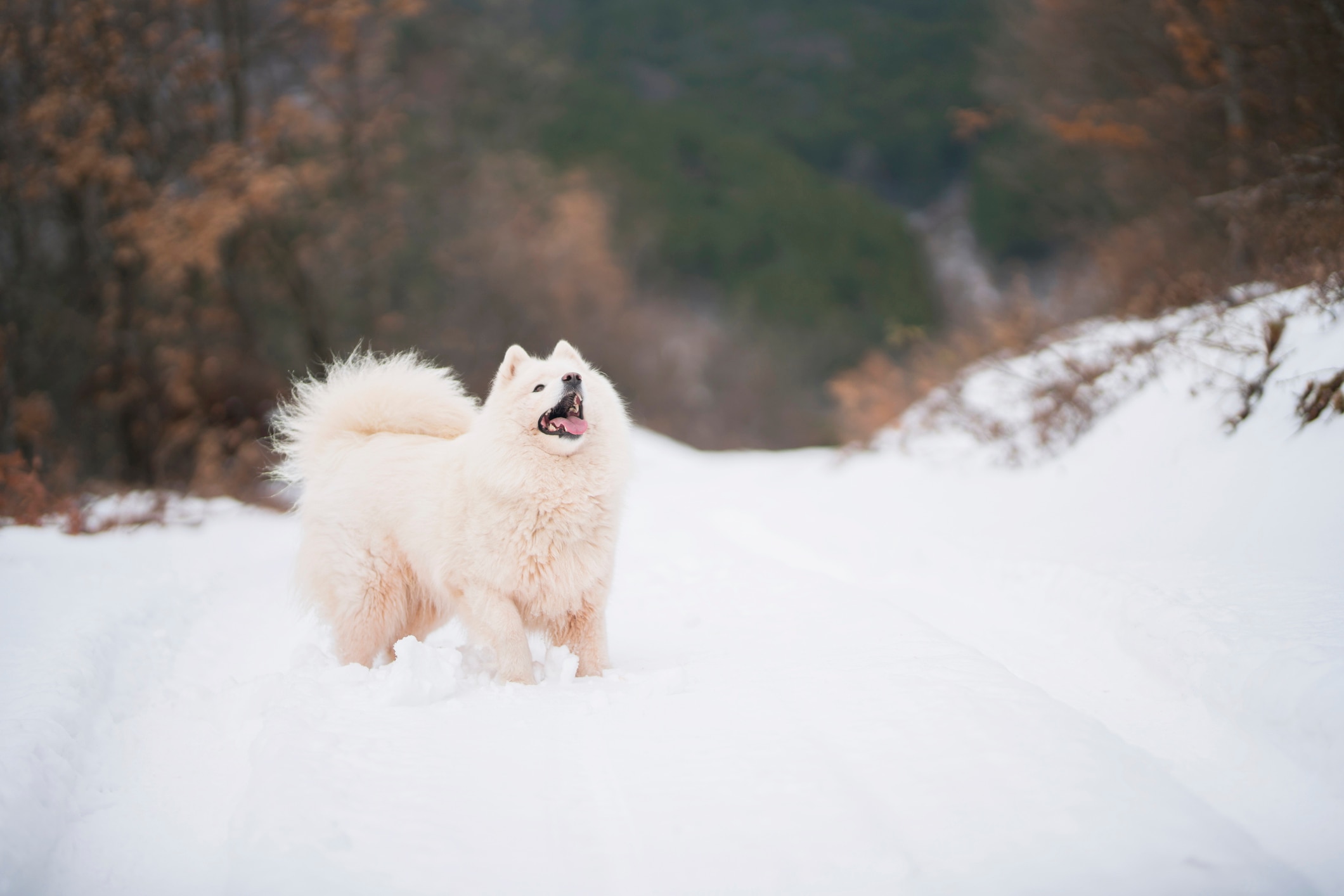
Some of the major considerations for Samoyed pet parents are the breed’s:
-
Sensitivity to warm temperatures
-
Need for lots of exercise and socialization
-
Potential genetic predisposition to eye problems, heart problems, hip dysplasia, and kidney disease
-
Daily grooming needs
Pet parents need to be prepared to address these concerns and any others that pop up with their Samoyed. These considerations are important because they can greatly affect the overall lifestyle of the Samoyed.
Samoyed FAQs
Is a Samoyed hypoallergenic?
No, Samoyeds are not considered to be a hypoallergenic dog breed. They have a thick fur coat that sheds year-round.
Is a Samoyed a good family dog?
Yes, Samoyeds can make excellent family companions as long as their needs are met. They are active, social, friendly, loving dogs.
Are Samoyeds smart dogs?
Yes, Samoyeds are smart dogs that can pick up training cues quickly.
How much does a Samoyed cost?
When purchased through a breeder, the cost of a Samoyed can be as much as several thousand dollars, especially if they have AKC registration.
However, there are Samoyed rescue organizations that have dogs available for adoption at lower costs. Likewise, some animal shelters may have Samoyeds for adoption.
Is a Samoyed a Husky?
No, Samoyeds and Siberian Huskies are different dog breeds, though both have northern origins.
Are there black Samoyed dogs?
No, all Samoyeds have a white or cream-colored coat. If you think you see a black Samoyed, you might be looking at another Spitz-type dog, like the Schipperke.
How is Samoyed pronounced?
The proper Samoyed pronunciation is suh-moy-uhd.
